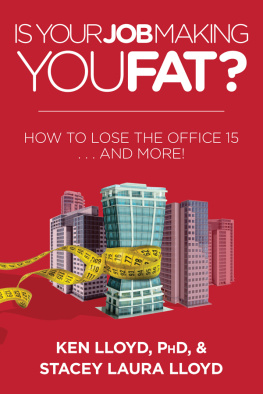Copyright 2016 by Ken Lloyd, PhD and Stacey Laura Lloyd
All rights reserved. No part of this book may be reproduced in any manner without the express written consent of the publisher, except in the case of brief excerpts in critical reviews or articles. All inquiries should be addressed to Skyhorse Publishing, 307 West 36th Street, 11th Floor, New York, NY 10018.
Skyhorse Publishing books may be purchased in bulk at special discounts for sales promotion, corporate gifts, fund-raising, or educational purposes. Special editions can also be created to specifications. For details, contact the Special Sales Department, Skyhorse Publishing, 307 West 36th Street, 11th Floor, New York, NY 10018 or .
Skyhorse and Skyhorse Publishing are registered trademarks of Skyhorse Publishing, Inc., a Delaware corporation.
Visit our website at www.skyhorsepublishing.com.
10 9 8 7 6 5 4 3 2 1
Library of Congress Cataloging-in-Publication Data is available on file.
Cover design by Rain Saukas
ISBN: 978-1-63450-564-2
Ebook ISBN: 978-1-5107-0152-6
Printed in the United States of America
This book is intended as a reference volume for informational purposes only. Before engaging in any weight management or exercise program, consult first with your physician. The books content is structured to assist you in making effective decisions about weight loss and conditioning, and it is not intended as an alternative to any advice or treatment provided by your physician. The authors and the publisher specifically disclaim any responsibility for unfavorable outcomes that may follow or result from the information provided in this book.
To Roberta Lloyda.k.a. Kens wife and Staceys mom
Contents
Introduction
W hen you step on your bathroom scale and take a look at the numbers, are you in disbelief? Up and up the digits fly, settling at a figure that just cant be right. But its your figure. Your mind races. Maybe youre not standing on the right spot, so you move back an inch. No difference. Maybe the scales broken. Fat chance. Maybe theres extra weight from your clothes. But youre in your underwear. Maybe its time to stop saying maybe and look at the real reason why youre gaining weight. Is your job making you fat? Yes!
This weighty conclusion is not based on conjecture, anecdotes, hypotheses, or suppositions. Its based on fact. You might be wondering how this can be? If the definition of work includes labor, toil, and exertion to achieve a particular outcome, how in the world can working be fattening? It seems counterintuitive. The traditional mindset is that if youre busy working, youre burning calories. And if youre burning calories, youre going to lose weight. Unfortunately, this classical thinking has become outdated.
There have been major changes in the nature of work and the goings-on in the workplace that have turned many of todays jobs into ideal positions for putting on pounds. This largely unrecognized fact has become the elephant in the roomand if you dont take action now, thats what youll become, too. How do you connect the dots and clearly see that your job is the cause of your burgeoning waistline? And more importantly, how do you take action to stop this ballooning trend before you pop out any further? The answers are in this book.
Take a look at todays workplaces versus those of the 1960s. Back then, places of work were a flurry of activity. Employees were up and about, carrying files from office to office, rushing from one meeting to another, and shifting paperwork and reports from here to there. Workplaces of the Sixties were a whirlwind of bustle, motion, and movement. In that era, it took a considerable amount of physical activity and energy to get most jobs done, whether they were white collar or blue.
Throughout the subsequent decades, however, the amount of physical activity associated with the vast majority of jobs has been in a steady state of decline. While approximately 50 percent of all jobs in 1960 required at least moderate physical activity, that number has dropped to a mere 20 percent today. And to make matters worse, a related finding shows that the remaining 80 percent of jobs typically call for minimal physical activity. As was spelled out in the scientific journal PLoS One , this transition in the workplace over the years has led to a situation where employees are burning 120 to 140 fewer calories per day when at work. And when you consider that this is happening across the United States labor force of more than 144 million workers, you start to get a much clearer idea of whats behind todays obesity epidemicand whats behind the large behinds. After all, recent figuresso to speakshow that approximately 75 percent of men and 66 percent of women in the United States are overweight or obese.
If you picture todays workplaces, what typically comes to mind is a proliferation of cubicles with inert humans using keyboards. Fingers are getting exercise, but people arent. Moving files and papers? It only takes a click. As for meetings? Go online or use video conferencing. Want to discuss something with your boss? Send her an email. Need to pick up the phone? Talk into your headset. Millions of jobs that used to call on employees to zip around now call for them to sit around. As a result, millions of calories are now being waisted.
Do you sit for most of the day in front of your computer, on phone calls, and in meetings? Is your work area so ergonomically correct that you hardly need to move in order to access every conceivable item you may ever need to get your job done? If so, youre working in a perfect incubator for increasing your weight. At the same time, while being sedentary contributes to weight gain, there are many other inflationary elements that come uniquely together in the workplace and exponentially increase the likelihood that youre going to expand. The first step is to identify these causes, and the second step is to control them. Some are overt and in your faceand will ultimately lead you to stuff your facewhile others are more sneaky and sinister. In combination, they team up to make you fatten up.
These figure-filling factors are spelled out in detail in the chapters that follow. While its important to recognize the factors on your job that are making you fat, its even more imperative to develop plans, strategies, priorities, benchmark dates, and measurement methods to successfully deal with them. There are actions you can take to lose weight right now. And keep it off for good. This isnt a diet. This isnt a fad. This is simply a matter of applying the same planning, energy, drive, focus, attention, and commitment that you place on every goal at work to the goal of preventing your job from making you fat.
The proof is in the pudding, so to speak. As was found in a landmark 2012 study conducted by CareerBuilder, after surveying more than 5,700 workers from a variety of industries, the irrefutable conclusion was that when people are at work, they tend to gain weight. In fact, of the wide range of individuals surveyed, 44 percent responded that they gained weight in their current job. The researchers also found that 26 percent of the surveyed workers gained more than ten pounds, and 14 percent gained over twenty pounds. Theres even a common expression that describes the weight gain thats associated with workits called the office fifteen. Much like the freshman fifteen referring to the typical weight gain of a college freshman adjusting to a new life of pizza and partying, the office fifteen stands for the fifteen pounds that employees are likely to gain in the first few months of taking on an office job. And worse, the odds are that they will gain even more weight over the years to come.











